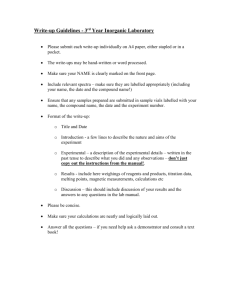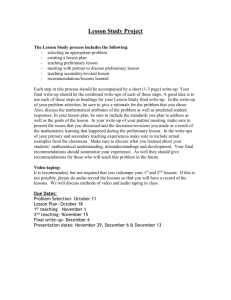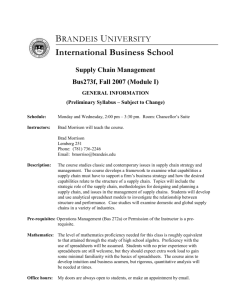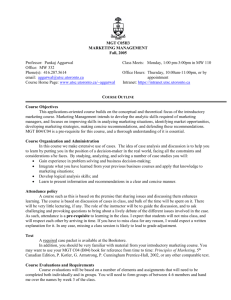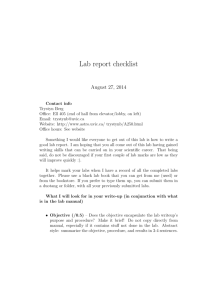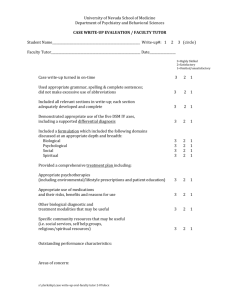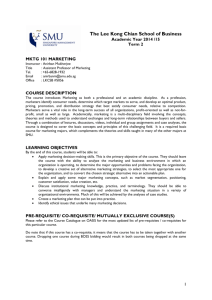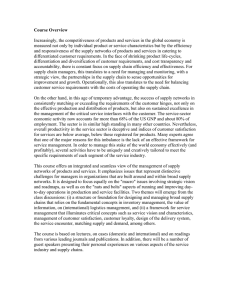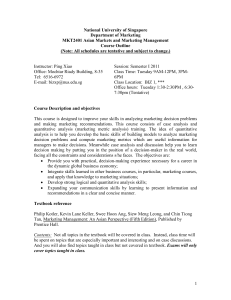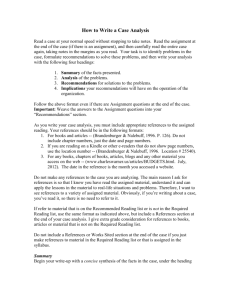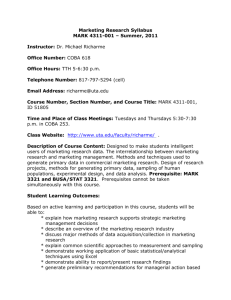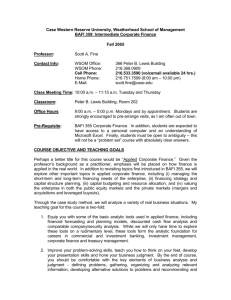Supply Chain Management
advertisement
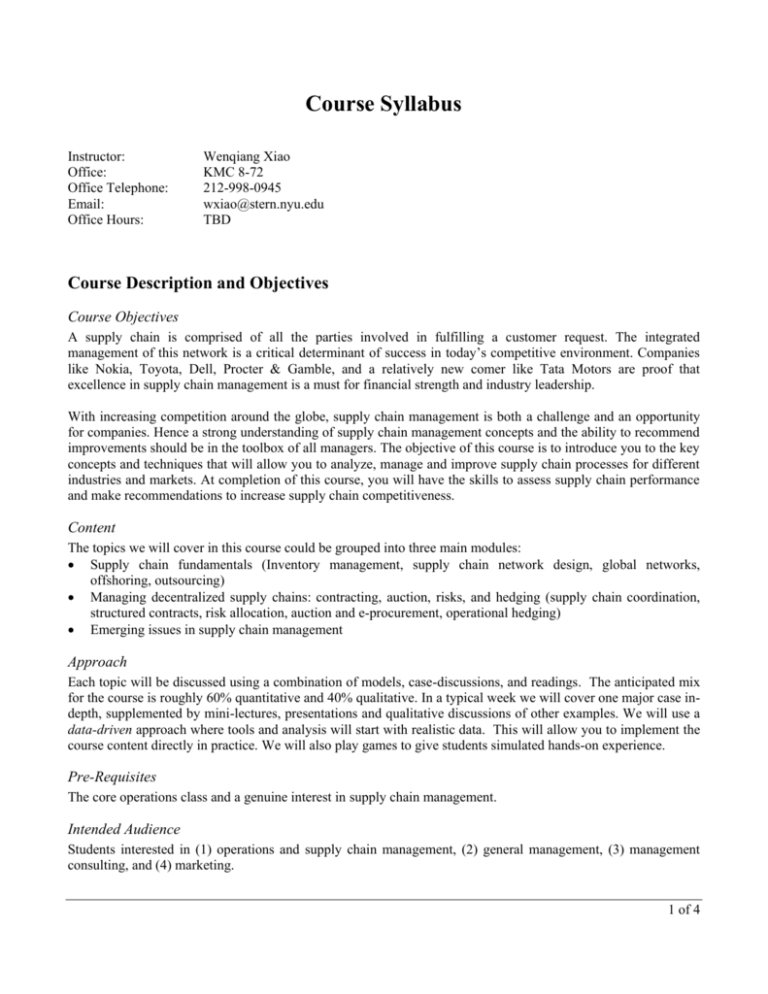
Course Syllabus Instructor: Office: Office Telephone: Email: Office Hours: Wenqiang Xiao KMC 8-72 212-998-0945 wxiao@stern.nyu.edu TBD Course Description and Objectives Course Objectives A supply chain is comprised of all the parties involved in fulfilling a customer request. The integrated management of this network is a critical determinant of success in today’s competitive environment. Companies like Nokia, Toyota, Dell, Procter & Gamble, and a relatively new comer like Tata Motors are proof that excellence in supply chain management is a must for financial strength and industry leadership. With increasing competition around the globe, supply chain management is both a challenge and an opportunity for companies. Hence a strong understanding of supply chain management concepts and the ability to recommend improvements should be in the toolbox of all managers. The objective of this course is to introduce you to the key concepts and techniques that will allow you to analyze, manage and improve supply chain processes for different industries and markets. At completion of this course, you will have the skills to assess supply chain performance and make recommendations to increase supply chain competitiveness. Content The topics we will cover in this course could be grouped into three main modules: Supply chain fundamentals (Inventory management, supply chain network design, global networks, offshoring, outsourcing) Managing decentralized supply chains: contracting, auction, risks, and hedging (supply chain coordination, structured contracts, risk allocation, auction and e-procurement, operational hedging) Emerging issues in supply chain management Approach Each topic will be discussed using a combination of models, case-discussions, and readings. The anticipated mix for the course is roughly 60% quantitative and 40% qualitative. In a typical week we will cover one major case indepth, supplemented by mini-lectures, presentations and qualitative discussions of other examples. We will use a data-driven approach where tools and analysis will start with realistic data. This will allow you to implement the course content directly in practice. We will also play games to give students simulated hands-on experience. Pre-Requisites The core operations class and a genuine interest in supply chain management. Intended Audience Students interested in (1) operations and supply chain management, (2) general management, (3) management consulting, and (4) marketing. 1 of 4 Grading Policy The grade you receive for the course is intended to certify your demonstrated proficiency in the course material. Proficiency will be estimated by measuring your performance in: 1. 2. 3. 4. Class Participation: Assignments (2): Case Write-ups (2): Final exam: Individual Individual Group Individual 20% 20% 30% 30% Class Participation This is your contributions to create and enhance a positive learning environment for this course. Grading will be based on the quality and impact of your class participation, not on quantity (although a minimum amount of the latter is necessary to deliver on the former.) Voluntary class participation will consist of voluntary contributions and occasional cold calls, usually to answer opening questions. Please leave your name-card up for the entire duration of each class and keep the same seat for the duration of the course. A thorough preparation of the assigned materials is all that is necessary for such leadoff questions. If you feel uncomfortable with being called on in class please let me know in advance so that we can agree on an alternative mode of interaction. Attendance and Classroom Etiquette Your attendance is expected for each class session. Please notify me in advance if you have to miss a class due to a legitimate reason. Participation scores may be adjusted for students who have poor attendance record. When you attend, you will be expected to conduct yourself professionally and respectfully during class, which means being attentive and considerate of others in the class. This means refraining from the use of cell phones, text messaging, email, reading the newspaper, etc. during class. Participation scores may be adjusted for students who consistently display unprofessional behavior. Laptop Policy Many students (and this professor) find the use of laptops during class to be distracting. Therefore, except when instructed by the professor, please refrain from using your laptop during class. Assignments Assignments are to be done by an individual. Please read guidelines for the individual assignments later in this syllabus. Case Write-ups Case write-ups are to be done by a group. Please read guidelines for the group case write-ups later in this syllabus. Groups should have 2 to 3 students, each of them bringing different strengths to the table. 2 of 4 Course Materials There are no required textbook for this course. However, the following three books are good sources of supplemental reading: Operations Strategy: Principles and Practice by Jan A. Van Mieghem. Dynamic Ideas, 2008. Supply Chain Management by Chopra and Meindl. Prentice Hall, 2009. Managing Supply Chains: Concepts, Tools, and Applications by Ananth V. Iyer. Hercher Publishing Incorporated, 2013. Guidelines for the Individual Assignments Format Format: 11 point font, 1 inch margins on all sides, line spacing of 1.5. Exhibits must be relevant and described in the text. Although there is no page limit on the assignments, you are expected to be concise and only show relevant details of your approach and solutions. Hand in a hardcopy before the start of the class when the assignment is due. (Need not submit an electronic copy.) Guidelines for the Group Case Write-ups Format A group case write-up is not to exceed 3 pages of typed text plus maximally 3 supporting exhibits. (Format: 11 point font, 1 inch margins on all sides, line spacing of 1.5. Each exhibit should not exceed one page.) Exhibits must be relevant and described in the text. Hand in a hardcopy at the beginning of the class on the due date. Structure A good write-up should clearly and succinctly state: 1. Your recommendation in the first paragraph to provide the reader with a framework (if a lengthy description of the recommendation seems necessary, append it to the report). 2. To stay in line with the objective of the course, the second part of the write-up should always qualitatively analyze and assess the supply chain strategy of the company (“the big picture”). 3. The remaining part of the write-up should explain your quantitative analysis (in words), what the key sensitivities are, and use it to justify your specific recommendation taking into account both the desirable and undesirable consequences of adopting it. If there are options under consideration in the case that you reject, a clear rationale for your decision should be provided. Keep in mind that you write to someone who knows all the facts in the case—no need to repeat them. A good report is not a chronology of analysis, but a clearly articulated statement of recommendation and support. Finally, the case write-up should answer the key questions in the case (and not be just an answer to the guiding questions that come with the case). Main expectation Each case write-up must have (1) an analysis and assessment of the big picture of the current supply chain strategy and (2) a quantitative analysis that must be used to justify your specific supply chain strategy recommendation as it pertains to the problem of the case. 3 of 4 Course Schedule (This schedule is only tentative and subject to changes.) Class Date Module and Description Part I. Supply Chain Fundamentals 1 Introduction to Supply Chain Management 2 3 Inventory Management in Supply Chain Supply Chain Network Design Case/Readings Events Shining Examples Manufacturing Complexity The Greatest Supply Chain Disasters of All Time Case: Llenroc Plastics: The Atlantic Distribution System 4 Global Networks and Offshoring Mini-Case: Mexico or China? Managing a Global Network 5 Global Dual Sourcing Game: Dual Sourcing Game Outsourcing and Mass Case: Timbuk2 Customization Part II. Managing Decentralized Supply Chains: Contracting, Auction, Risks, and Hedging 7 Supply Chain Contracting and Turning Your Supply Chain into a Revenue Chain Risk Allocation 8 Contracting under Exchange Rate Risks 9 Supplier Selection: Auction Case: Procurement at Betapharm Corp. (A) and e-Procurement 10 Operational Hedging: Case: Seagate Technology Capacity Portfolio and Selection Part III. Emerging Issues in Supply Chain Management 11 Sustainability and Green Case: Walmart’s Sustainability Strategy Supply Chains The Greening of Walmart’s Supply Chain…Revisited 12 Supply Chain Disruption 6 4 of 4
